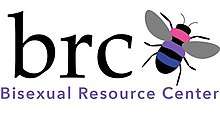Bisexual Resource Center
 Bisexual Resource Center (BRC) Logo | |
| Formation | 1985 |
|---|---|
President | Kate Estrop |
| Website |
biresource |
| Bisexuality topics |
|---|
| Related sexual orientations |
| Sexual identities |
| Studies |
| Attitudes and discrimination |
| Bisexual community |
| Lists |
| Portals |
|
The Bisexual Resource Center (BRC) is a 501(c)(3) non-profit educational organization headquartered in Boston, Massachusetts, that has served the Bisexual community since 1985. Originally known as The East Coast Bisexual Network, it incorporated in 1989 as a 501(c)(3) nonprofit and changed its name to the Bisexual Resource Center in 1993.[1][2][3]
Describing itself as one of the oldest nationally focused bisexual organizations in the U.S. the BRC's current president is the Graphic designer and Webcomic artist[4] Kate Estrop.[3][5] It provides education about bisexual and progressive issues and support for bisexual people. The organization, the most active American bisexual advocacy and resource group,[2] also sponsors bi-positive programming, holds a support group, promotes visibility at Pride events and provides speakers about bisexuality.
It has a "long-standing role as a clearinghouse for bisexual information, " and has a lending library with approximately 200 books about bisexuality and some movies.[6] In 1987 The East Coast Bisexual Network (as it was then known) established the first Bisexual History Archives with Robyn Ochs's initial collection; archivist Clare Morton hosted researchers.[1]
The BRC publishes the biannual Bisexual Resource Guide, a comprehensive listing of bisexual and bi-inclusive organizations,[6] bi-related books and films,[7] web sites, and academic articles.[8] The first edition was published in the mid-1980s.[9]
The BRC produces Getting Bi: Voices of Bisexuals Around the World, now in its second edition. The anthology is edited by Ochs and Sarah E. Rowley and has 220 entries from people from 42 countries. Topics include coming out, relationships, politics, community, and more. The book also addresses the intersection of bisexuality with race, class, ethnicity, gender identity, disability and national identity.
The BRC had its first float at the Boston LBGT Pride parade in 2010.[10] In 2014, the BRC declared March of that year as the first "Bisexual Health Awareness Month", with the theme "Bi the Way, Our Health Matters Too!".[11]
See also
References
- 1 2 "BiNet USA website". BiNet USA. Retrieved 2014-06-29.
- 1 2 Sears, James Thomas (2005). Youth, Education, and Sexualities: A-J. Greenwood Publishing Group. p. 92.
- 1 2 "Bisexual Resource Center website". Bisexual Resource Center. Retrieved 2017-11-03.
- ↑ "A bi-themed webcomic of miniatures". Tiggy Upland. 2016-07-28. Retrieved 2017-11-03.
- ↑ "TIPS: Including Bisexual People in Your Advocacy". Equality Federation. 2017-02-15. Retrieved 2017-11-03.
- 1 2 Ellis, Alan (2002). The Harvey Milk Institute guide to lesbian, gay, bisexual, transgender, and queer internet research. Psychology Press. pp. 57–58.
- ↑ Garnets, Linda; Kimmel, Douglas C. (2003). Psychological perspectives on lesbian, gay, and bisexual experiences. Columbia University Press. p. 261.
- ↑ Ochs, Robyn (1999). "Resources for Bisexual Women". In Orndorff, Kata. Bi lives: bisexual women tell their stories. See Sharp Press. p. 248.
- ↑ Siker, Jeffrey S. (2007). Homosexuality and religion: an encyclopedia. Greenwood Publishing Group. p. 72.
- ↑ Bisexual Resource Center
- ↑ ""Bi the way, our health matters too!" – It's Bisexual Health Awareness Month!". GLAAD. 2014-03-03. Retrieved 2014-06-29.
External links
- Bisexual Resource Center — official website
- The Bisexual Resource Center records, 1983–2002 are located in the Northeastern University Libraries, Archives and Special Collections Department, Boston, MA.